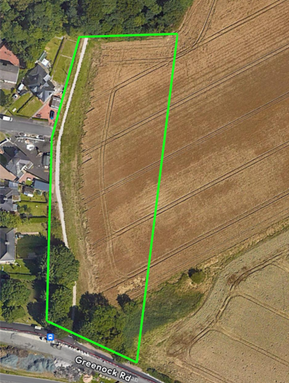Teucheen Accessible Nature Space - Community Asset Transfer Survey
- Inchinnan Development Trust
- Aug 20, 2024
- 4 min read

A view of the site from Greenock Road.
IDT are in the first stages of applying for a Community Asset Transfer of an important local asset, an area of farmland adjacent to Teucheen Wood’s main entrance path.
The community of Inchinnan have long expressed a desire for the preservation of Inchinnan’s greenbelt, diverse habitats, and natural heritage - both for the benefit of people and wildlife. The Trust was established with this goal in mind, and following the success of bringing Teucheen Wood into community ownership, set its sights on other local assets highlighted by our community members.
At the top of this list, following Teucheen Wood, was this farmland site. The site was identified as being in need of community management, owing to its central location in the village, potential for improvement, and high risk of loss due to Renfrewshire Council’s plans to use the site for house building.
IDT wish to see this piece of land preserved and brought into community ownership to allow for habitat restoration/creation and creation of an accessible nature space to be incorporated into our existing programme of community activities (including our volunteering, educational, and wellbeing sessions).
A Summary of Site Plans and Proposals
Boundary of the site and illustrative concept map showing proposals.
Plans for the site will transform it, from ecologically-poor monoculture farmland, into a thriving biodiverse space for both community and wildlife. The site will provide both quality habitat for our wildlife population but also an accessible ‘nature experience’ for our community members.
Accessible Nature Space & Community Involvement
This space creates a unique opportunity for the Trust to create a fully accessible nature space (due to its flat terrain and ease of access from Greenock Road), offering an alternative to the challenging terrain of Teucheen Wood. The centre of the site will become an inclusive nature space with a fully accessible path loop (suitable for use by mobility equipment and pushchairs), rest benches, and interactive nature interpretation boards providing insight into the surrounding habitats. The planting of wildflower species and orchard trees in the areas around the path loop will create a vibrant, engaging natural space.
It is hoped that this area will become a new space for community recreation while also being able to support the various nature-based activities which currently take place in Teucheen Wood (e.g forest school, nature wellbeing, volunteering) while extending their availability to those who may be unable to navigate the rough woodland terrain.
Another exciting prospect, is the opportunity for an archaeological investigation of the site (prior to path construction and habitat creation) to explore its connection to the Battle of Renfrew. The Trust is working with Inchinnan Historical Interest Group to discuss the feasibility of this.
Wildlife Habitat Restoration & Creation
The Trust plans to increase biodiversity of the site through the creation and restoration of wildlife habitat - supporting local wildlife, introducing new species, and promoting ecological balance. Community involvement and educational programs will be an important part of this work, providing opportunity for learning/skill building and raising awareness about the importance of biodiversity improvement.
A full overview of our plans for environmental improvements to the site can be found in our Habitat Creation & Restoration document.
Woodland Edge Habitat
The northern area of the site currently forms an unnatural, harsh edge with the woodland, with the mature trees of Teucheen directly abutting farmland. The Trust plans to expand Teucheen’s woodland habitat through the planting of flower-rich and fruit/nut bearing shrubs and trees (alongside woodland fringe wildflowers and plug plants). This will create a softer, more natural woodland edge habitat - creating a transition zone which better supports biodiversity and woodland wildlife.
Wet Grassland Habitat
The southern section of the site will be restored to a wet grassland habitat through natural re-wetting, the creation of small wader scrapes (shallow standing water features), planting of wetland vegetation, and the expansion of the reedbed fragment to the east of the site. These improvements will support wetland bird species currently using the area (e.g Reed Bunting and Sedge Warbler), increase the attractiveness of the site for new species (such as Grasshopper Warbler), and provide new educational opportunities on wetland habitat and the species it supports.
Miscellaneous
A native hedgerow will be planted along the eastern boundary of the site to increase availability of hedge habitat, improve habitat connectivity (creating a connection between Teucheen Wood and the woodland/hedge habitat at the southern boundary of the site) and create a buffer between the site and neighbouring land. A beetle bank will also be created on-site using excavated material from path construction and excavation of wader scrapes.

Sedge warbler in reedbed, wetland wader scrape, and an Emerald Damselfly (Images: Canva Pro Gallery)











Comments